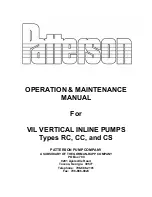
Maintenance
E:\shares\Baprod\BA\subtec_m\sewage\us\fkt27\maintenance.fm
7-5
Bi-metal sensor: Value = “0” - throughput
PTC sensor: A PTC sensor has a cold resistance of between 20 and 100ohms. For 4 sensors in series
this would result in a value of between 80 and 400ohms.
PT 100 sensor: PT 100 sensors have a value of 100ohms at 0°C. Between 0°C and 100°C this value
increases by 0.385ohms per 1°C. PT 20 sensors have a value of 107.7ohms at 20°C.
Moisture sensor: This value must go towards infinity. If there is a low value, there is water in the oil.
Also observe the instructions of the optionally available evaluation relay.
In the case of larger deviations, please consult the manufacturer.
Please consult the appropriate operating manual for details on inspecting the safety and monitor-
ing devices on the auxiliary lifting gear.
General overhaul
During this the bearings, shaft seals, O rings and power supply cables are inspected and replaced as
required in addition to normal maintenance work. This work may only be conducted by the manu-
facturer or an authorized service workshop.
Changing the lubricant
The drained lubricant must be checked for dirt and water content. If the lubricant is very dirty and
contains more than 1/3 water, it must be changed again after four weeks. If there is again water in
the lubricant then, it seems likely that a seal is defective. In this case, please consult the manufac-
turer.
If a sealing room or leakage monitoring system is being used, the display will light up again within
four weeks of changing the lubricant if a seal is defective.
The general procedure for changing lubricants is as follows:
Switch off the machine, let it cool down, disconnect it from the mains
(have this done by an electrician), clean it and place it vertically on a
solid base.
Warm or hot lubricants may be pressurized. The leaking lubricant may
cause burns. For that reason, let the machine cool down to ambient tem-
perature before you touch it.
Secure it from falling over and/or slipping. For certain housing coatings
(e.g. Ceram C0) the plugs are protected with plastic covers. These must
be removed and put back on after a successful lubricant change. They
must be lined with an acid-resistant sealant (such as SIKAFLEX 11FC).
Sealing chamber
1
Slowly and carefully remove the plug (D) from the sealing chamber.
Caution: The lubricant in the motor chamber may be pressurized.
2
Drain the lubricant and collect it in a suitable reservoir. For complete drainage, the machine
must be slightly tipped on to its side.
Make sure that the machine cannot fall and/or slip away.
















































